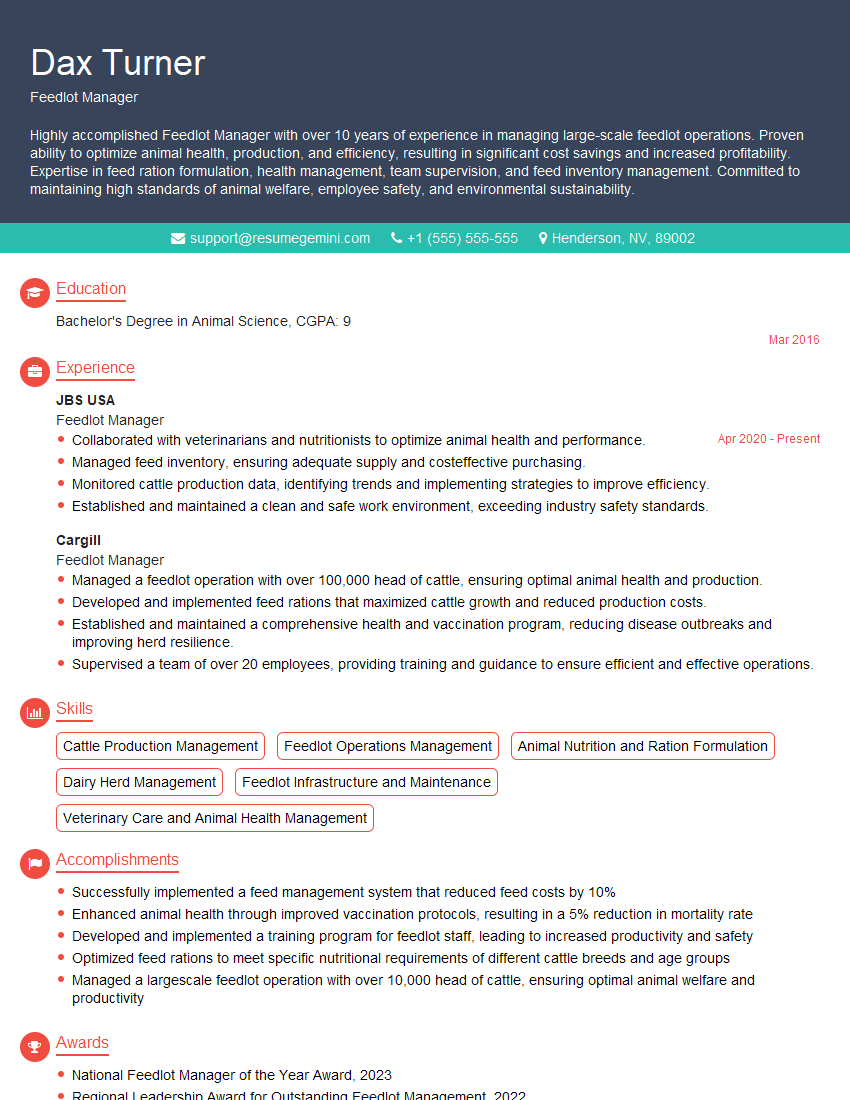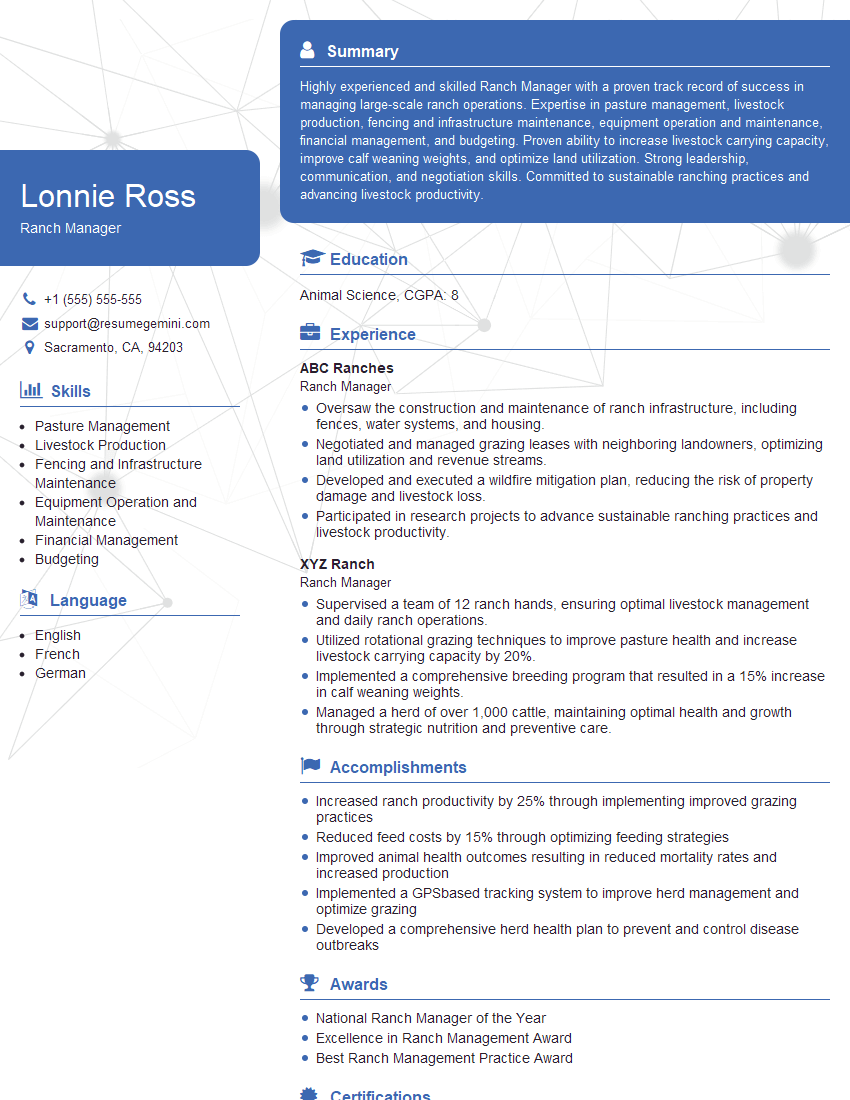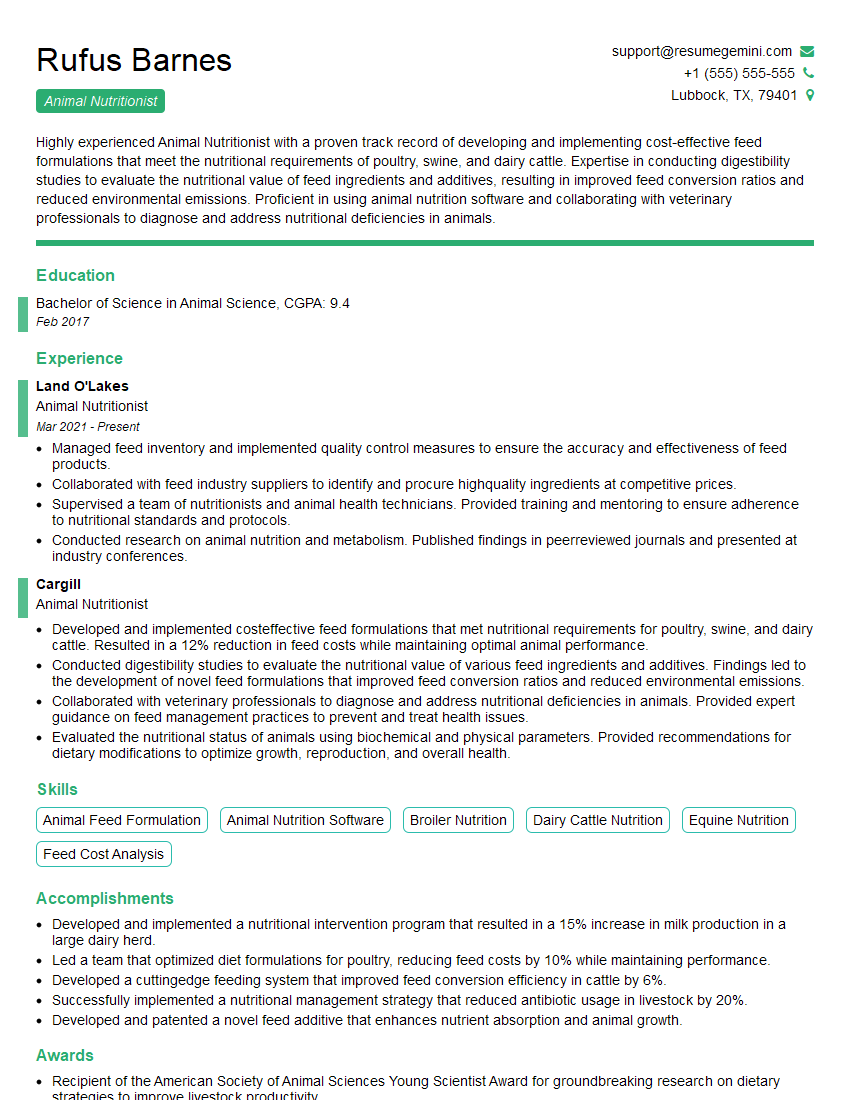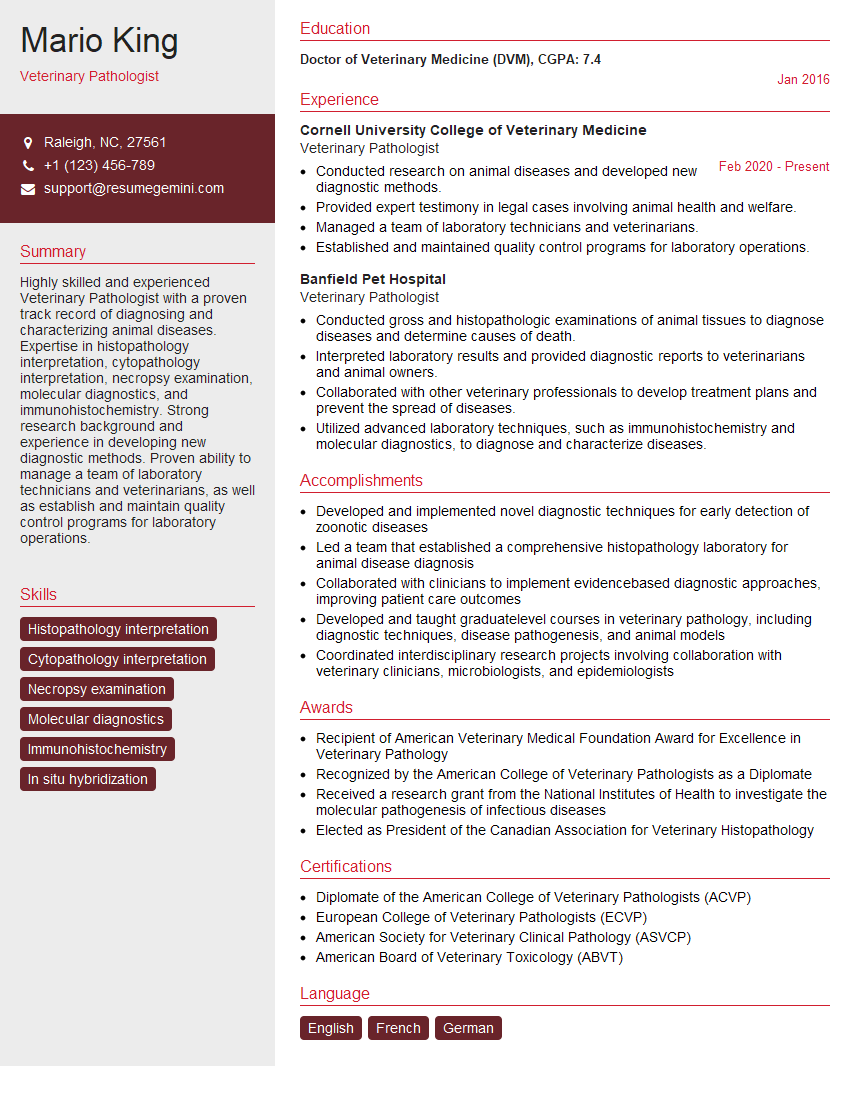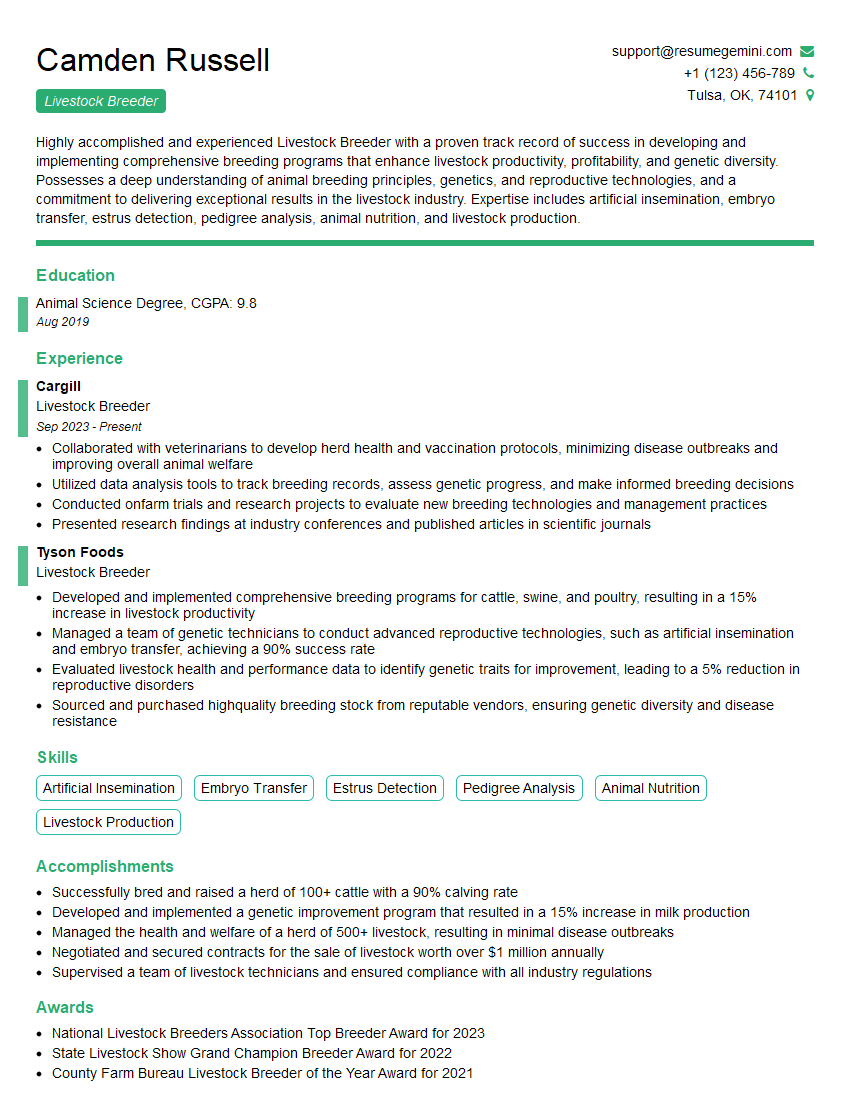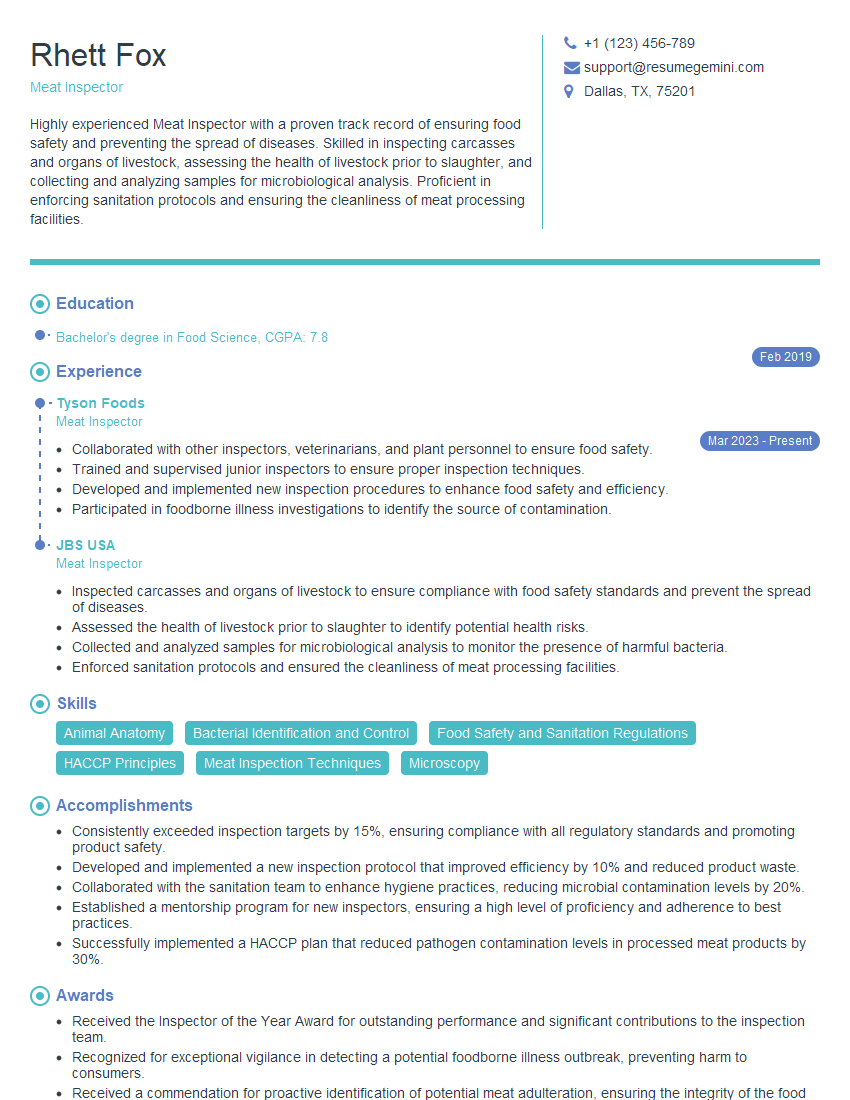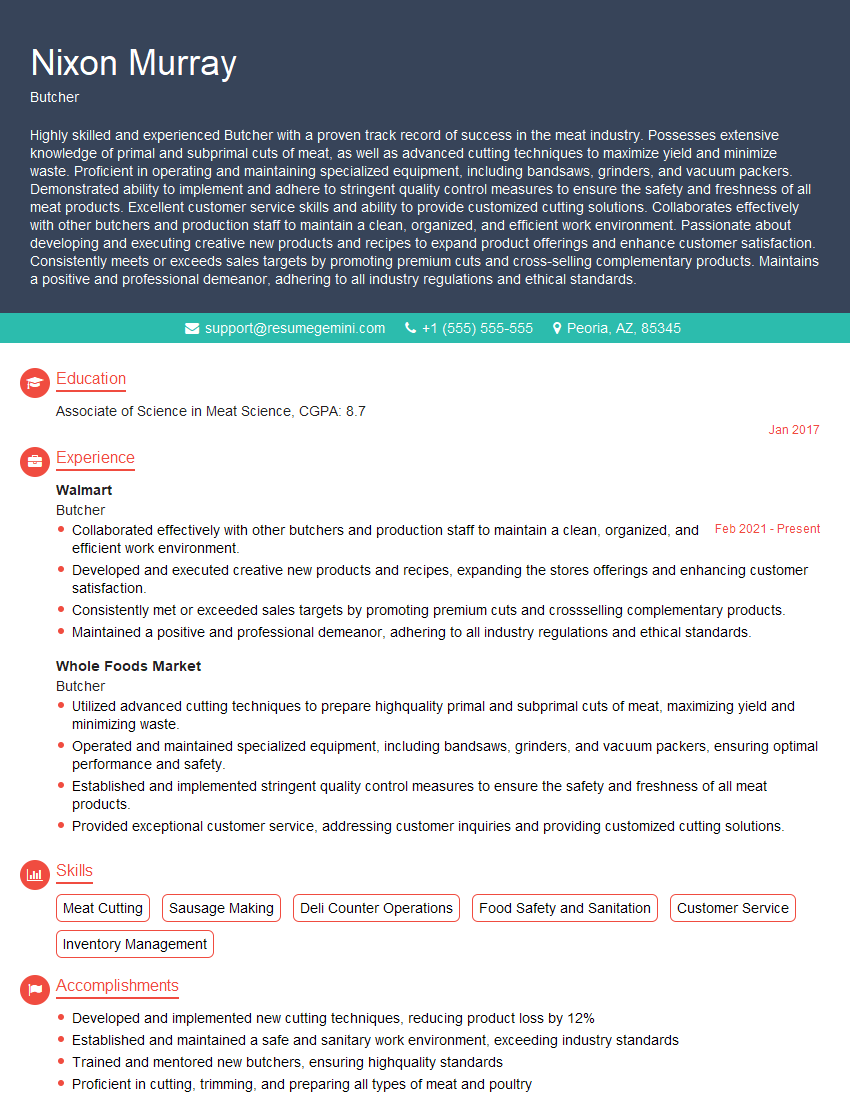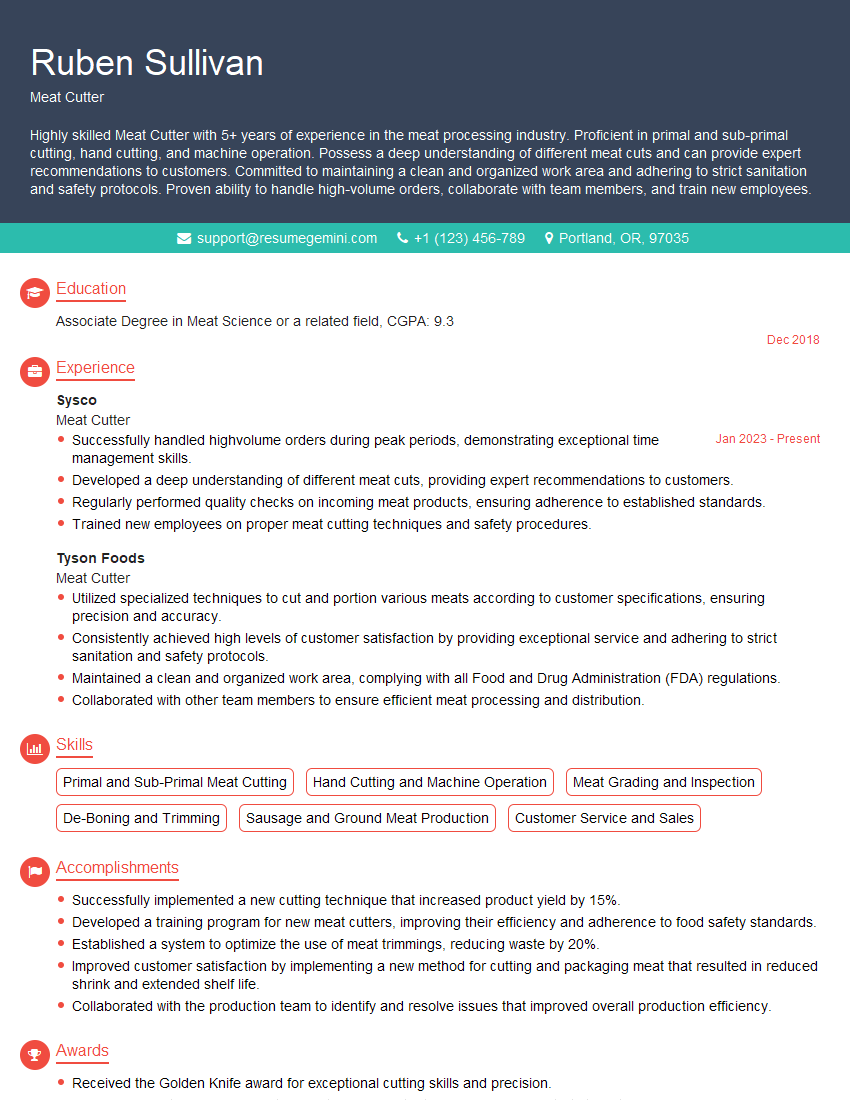Cracking a skill-specific interview, like one for Anatomy and Physiology of Meat Animals, requires understanding the nuances of the role. In this blog, we present the questions you’re most likely to encounter, along with insights into how to answer them effectively. Let’s ensure you’re ready to make a strong impression.
Questions Asked in Anatomy and Physiology of Meat Animals Interview
Q 1. Describe the digestive system of a pig.
The pig’s digestive system is remarkably efficient at extracting nutrients from a wide variety of feedstuffs, a characteristic that contributes to its rapid growth rate. It’s a monogastric system, meaning it has a single-chambered stomach, unlike ruminants like cattle. Let’s break it down:
- Mouth and Esophagus: The pig uses its strong jaws and teeth to break down feed. Saliva begins the digestive process, and the food is then swallowed and travels down the esophagus to the stomach.
- Stomach: The stomach secretes hydrochloric acid and pepsin, initiating protein digestion. The stomach’s churning action further breaks down the food.
- Small Intestine: This is where the majority of nutrient absorption occurs. The pancreas and liver secrete enzymes and bile into the small intestine, aiding in the digestion of carbohydrates, fats, and proteins. The small intestine’s lining is highly folded, increasing the surface area for absorption.
- Large Intestine: The large intestine absorbs water and electrolytes from the remaining undigested material, forming feces. Bacteria in the large intestine aid in fermentation, though less extensively than in ruminants.
- Rectum and Anus: Feces are stored in the rectum and eliminated through the anus.
Understanding the pig’s digestive system is crucial for optimizing feed efficiency and overall animal health. For example, knowing that pigs readily digest both plant and animal-based feeds informs feed formulation strategies.
Q 2. Explain the differences in muscle fiber types in beef cattle.
Beef cattle muscle, like that of other animals, is composed of different types of muscle fibers, each with distinct contractile properties. These differences significantly impact the tenderness and overall quality of the meat. The main fiber types are:
- Type I (Slow-twitch): These fibers are red in color due to a high myoglobin content. They are slow to contract and fatigue-resistant, crucial for sustained activities. They tend to be more tender.
- Type IIa (Fast-twitch oxidative): These are intermediate fibers, exhibiting characteristics of both Type I and Type IIb fibers. They have a moderate contraction speed and fatigue resistance.
- Type IIb (Fast-twitch glycolytic): These are white fibers, contracting rapidly but fatiguing quickly. They are less tender than Type I fibers.
The proportion of each fiber type varies depending on the muscle’s location and the animal’s genetics and diet. For example, muscles used for locomotion, like the round, tend to have a higher proportion of Type I and IIa fibers, resulting in potentially tougher meat compared to muscles with more Type IIb fibers.
Breed and genetics are crucial here: some breeds naturally have a higher percentage of tenderizing Type I fibers, influencing meat quality directly.
Q 3. What are the key factors affecting meat tenderness?
Meat tenderness is a complex trait influenced by a number of factors acting before and after slaughter. These include:
- Muscle Fiber Characteristics: As discussed earlier, the proportion of different muscle fiber types significantly influences tenderness. Muscles with a higher percentage of Type I fibers are generally more tender.
- Connective Tissue: The amount and type of connective tissue (collagen and elastin) within the muscle are major contributors. Collagen, when heated, breaks down and becomes gelatinous, increasing tenderness. Elastin, however, is less affected by heat, contributing to toughness.
- Postmortem Changes: Processes like rigor mortis (stiffening of muscles after death) and proteolytic enzyme activity affect tenderness. The rate and extent of these changes are influenced by factors like pre-slaughter stress and chilling rate.
- Age of Animal: Older animals tend to have tougher meat due to increased collagen cross-linking and higher connective tissue content.
- Marbling: Intramuscular fat (marbling) contributes to tenderness by lubricating muscle fibers and enhancing flavor.
- Pre-Slaughter Stress: Stress increases the rate of glycogen depletion, potentially resulting in accelerated rigor mortis and tougher meat.
Understanding these factors allows for the implementation of strategies to improve meat tenderness, such as aging, tenderization techniques, and careful management of animal welfare before slaughter.
Q 4. How does stress affect meat quality pre-slaughter?
Pre-slaughter stress significantly impacts meat quality. Stressful conditions lead to physiological changes that negatively affect the tenderness, color, and water-holding capacity of the meat. The primary mechanism involves the depletion of glycogen stores.
When an animal experiences stress, its body releases adrenaline and other stress hormones. This triggers a rapid breakdown of glycogen (the animal’s primary energy source) through anaerobic glycolysis. This process leads to a build-up of lactic acid, resulting in:
- Dark, firm, and dry (DFD) meat: Rapid glycogen depletion causes a lower pH, leading to darker color and reduced water-holding capacity, resulting in dry meat.
- Pale, soft, and exudative (PSE) meat: In some cases, extremely rapid glycogen depletion and acidification can lead to pale, soft, and exudative meat. This is due to excessive protein denaturation and loss of water-holding capacity.
- Reduced tenderness: The rapid pH decline associated with stress can lead to accelerated rigor mortis and increased toughness.
Minimizing stress during handling, transportation, and holding before slaughter is crucial for ensuring high-quality meat. This involves providing a calm and comfortable environment, minimizing exposure to stressful stimuli, and implementing humane handling practices.
Q 5. Describe the process of rigor mortis in poultry.
Rigor mortis in poultry, like in other animals, is the stiffening of muscles after death. It’s a natural biochemical process resulting from the depletion of ATP (adenosine triphosphate), the energy currency of muscle cells. Here’s a breakdown:
- Phase 1 (Delay Phase): Immediately after slaughter, muscles are relaxed and pliable. ATP levels are still relatively high, allowing the myosin and actin filaments in muscle cells to detach.
- Phase 2 (Onset of Rigor): As ATP levels decline, the myosin and actin filaments become irreversibly bound together, resulting in muscle contraction and stiffness. This phase is influenced by factors like temperature and pre-slaughter stress.
- Phase 3 (Rigor Completion): Rigor mortis reaches its peak, and the muscle is fully contracted and stiff. The duration of this phase can vary depending on factors like species, muscle type, and temperature.
- Phase 4 (Resolution of Rigor): Over time, the muscle proteins begin to break down due to the action of endogenous proteolytic enzymes (calpains), leading to a gradual softening of the muscle tissue. This is part of the meat tenderization process. This can be accelerated via ageing.
Understanding rigor mortis is critical for optimizing poultry processing. Controlling factors like chilling rate and pre-slaughter stress can influence the onset and resolution of rigor, impacting the final meat quality and tenderness.
Q 6. Explain the role of glycogen in meat quality.
Glycogen, the primary carbohydrate storage molecule in muscle tissue, plays a vital role in determining meat quality. Its role is primarily linked to postmortem pH decline.
After slaughter, glycogen is broken down into lactic acid through a process called anaerobic glycolysis. This lactic acid lowers the pH of the muscle. The rate and extent of this pH decline directly impact meat quality. A rapid decline can lead to PSE meat, while a slow decline can result in DFD meat. A desirable pH decline is moderate, resulting in acceptable meat color and water-holding capacity.
High pre-slaughter glycogen levels are essential for a desirable pH decline. Stress before slaughter depletes glycogen, which, as mentioned previously, leads to altered meat quality. Therefore, managing stress levels is critical to maintaining adequate glycogen stores and ensuring optimal meat quality.
In summary: Adequate glycogen levels are crucial for a normal postmortem pH decline, thereby ensuring meat with acceptable colour, juiciness, and tenderness.
Q 7. What are the major differences between the skeletal systems of sheep and goats?
While sheep and goats are closely related, there are subtle yet significant differences in their skeletal systems:
- Horn Structure: A key difference lies in horn structure. Sheep horns are typically curved and spiraled, while goat horns are often straighter and may have a more pronounced curvature. Furthermore, sheep horns are typically more bony, less hollow.
- Facial Profile: Goats generally have a more convex facial profile (Roman nose), whereas sheep have a more concave or straight profile.
- Tail Length and Carriage: Sheep typically have longer tails, often reaching to their hocks or lower. Goats usually have shorter tails, often carried upright.
- Overall Skeletal Size: There can be size differences; breed-specific size variations can make it difficult to create generalized rules.
These differences are relevant in various aspects, including meat yield and carcass characteristics. For instance, differences in skeletal structure can influence meat distribution across various cuts.
Careful observation of these characteristics is crucial for accurate species identification, especially in carcass evaluation and meat grading.
Q 8. Describe the physiological changes during the growth phases of a broiler chicken.
Broiler chicken growth is characterized by incredibly rapid muscle development, driven by selective breeding and optimized feeding regimes. We can break this down into several key phases:
- Embryonic Stage: This initial phase sees the development of the basic body plan and organ systems. Muscle fibers begin forming, laying the foundation for future growth.
- Starter Phase (0-3 weeks): This period focuses on rapid growth and development of the digestive system, crucial for efficient nutrient absorption from the high-protein starter feed. The chicks are highly vulnerable to disease during this phase.
- Grower Phase (3-6 weeks): Growth rate continues at a high pace, with increased muscle mass and bone development. The focus shifts to optimizing feed efficiency to minimize cost while maximizing growth.
- Finisher Phase (6-8 weeks): Growth slows slightly as the bird nears market weight. The emphasis is on finishing the bird for optimal carcass yield and quality. Feed formulations are often adjusted to improve fat deposition and meat texture.
Physiological changes include dramatic increases in body weight, bone length and density, and muscle fiber size and number. Metabolic rate remains high, requiring substantial energy intake. Understanding these phases allows for precise management of nutrition, environment, and disease prevention to maximize production efficiency and meat quality.
Q 9. How does breed affect carcass composition in swine?
Breed significantly influences swine carcass composition, impacting lean meat percentage, fat content, and overall yield. For example, lean breeds like Landrace and Yorkshire are selectively bred for higher lean muscle mass and lower fat deposition compared to heavier, fattier breeds such as Duroc. This translates directly to economic implications for producers. Leaner breeds are preferred for markets demanding leaner cuts, while fattier breeds might be favored for specific processed meat products requiring higher fat content.
Genetic factors within a breed also play a role. Within a breed, individual pigs will vary in their ability to deposit lean tissue versus fat, influenced by complex genetic interactions. Carcass composition is also modulated by environmental factors like nutrition and management practices, highlighting the complex interplay between genetics and the environment in determining final meat quality and yield.
Q 10. Explain the different types of fat deposition in meat animals.
Fat deposition in meat animals occurs in different forms and locations, significantly affecting meat quality and palatability. The primary types include:
- Subcutaneous Fat (Backfat): This is the fat deposited directly beneath the skin. It’s an important energy reserve and affects carcass grade in some species.
- Intermuscular Fat (Seam Fat): Located between muscles, seam fat contributes to marbling and tenderness but can also increase overall fat content.
- Intramuscular Fat (Marbling): This is the fat interspersed within the muscle tissue itself. It’s critically important for meat tenderness, juiciness, and flavor, enhancing palatability.
- Visceral Fat (Internal Fat): Found within the body cavity surrounding organs like the kidneys and intestines, visceral fat accumulation is often associated with lower meat quality and increased health risks in the animal.
The relative amounts of each fat type are influenced by genetics, diet, age, and sex of the animal. Management practices play a significant role in influencing fat deposition patterns, affecting both the economic value and consumer acceptability of the meat.
Q 11. What are the common diseases affecting the respiratory system of cattle?
Cattle respiratory diseases pose a significant challenge to the livestock industry, resulting in reduced productivity and economic losses. Some common conditions affecting the respiratory system include:
- Bovine Respiratory Syncytial Virus (BRSV): A highly contagious virus causing pneumonia, particularly in young calves.
- Bovine Viral Diarrhea Virus (BVDV): While affecting multiple systems, BVDV can manifest as respiratory disease, often worsening the effects of other respiratory pathogens.
- Infectious Bovine Rhinotracheitis (IBR): This herpesvirus causes upper and lower respiratory tract infections, sometimes leading to severe pneumonia.
- Pasteurellosis (Shipping Fever): Mannheimia haemolytica and other Pasteurella species cause pneumonia, often exacerbated by stress during transportation or overcrowding.
- Mycoplasmosis: Mycoplasma species cause chronic respiratory infections, reducing growth rates and productivity.
Effective disease prevention strategies include vaccination, biosecurity measures (like quarantine and hygiene practices), and proper management to minimize stress factors.
Q 12. Describe the reproductive cycle of a sow.
The sow’s reproductive cycle is a complex process involving several key stages:
- Estrus (Heat): This is the period of sexual receptivity, typically lasting 1-3 days. The sow exhibits behavioral signs like restlessness, mounting other sows, and vocalization.
- Ovulation: Release of eggs from the ovaries, usually occurring approximately 36-48 hours after the onset of estrus. Timing of artificial insemination is critical here.
- Gestation: The period of pregnancy, lasting approximately 114 days. During this time, the developing embryos implant in the uterine wall and grow.
- Parturition (Farrowing): The process of giving birth, typically lasting several hours. The sow experiences uterine contractions and expels the piglets.
- Lactation: The period of milk production, lasting approximately 3-4 weeks. The sow provides essential nourishment to the piglets.
- Post-Weaning Anestrus: A period of reproductive inactivity following weaning, which can last for several days to weeks.
Management practices aimed at optimal nutrition, housing, and breeding protocols are crucial for maximizing reproductive efficiency in sows. Understanding the different stages of this cycle is vital for effective farm management.
Q 13. What are the different methods of stunning animals before slaughter?
Stunning animals before slaughter is essential to minimize pain and suffering. Different methods are used, each with its own advantages and limitations:
- Electrical Stunning: This involves passing an electrical current through the animal’s brain, rendering it unconscious. It’s widely used due to its effectiveness and relatively quick action.
- Captive Bolt Stunning: A captive bolt pistol fires a bolt into the animal’s brain, causing immediate unconsciousness. This method requires precision and proper training to ensure effectiveness.
- Carbon Dioxide Stunning: Exposure to CO2 induces unconsciousness. This method is generally considered humane but can take longer than electrical or captive bolt stunning, and requires appropriate gas flow and concentration.
The choice of stunning method depends on factors like animal species, size, and available equipment. Properly performed stunning is crucial for ensuring humane slaughter and maximizing meat quality. Improper stunning can lead to pain and stress in the animal, and can impact meat quality.
Q 14. Explain the importance of proper handling and transportation of livestock.
Proper handling and transportation of livestock are paramount for animal welfare, reducing stress, injury, and disease transmission. Poor handling can significantly impact meat quality, increase the risk of injury and death, and result in economic losses.
Key aspects of proper handling include:
- Minimizing Stress: Avoid overcrowding, loud noises, and sudden movements.
- Gentle Handling Techniques: Use calm and controlled movements when handling animals.
- Appropriate Restraint: Utilize appropriate equipment and techniques to restrain animals safely and efficiently without causing injury.
- Well-Maintained Transport Vehicles: Vehicles should be clean, appropriately ventilated, and equipped to prevent injury during transportation.
- Adequate Rest Stops: Provide sufficient rest stops during long-distance transportation to allow animals to rest and rehydrate.
Implementing best practices in handling and transportation ensures compliance with animal welfare regulations and leads to improved animal health, reduced stress, and better quality meat. Proper training of personnel involved in livestock handling and transportation is vital to effective implementation of these best practices.
Q 15. What are the key indicators of meat freshness?
Assessing meat freshness is crucial for food safety and quality. Several key indicators help determine if meat is suitable for consumption. Think of it like assessing the ripeness of a fruit – you wouldn’t eat an overripe or rotten one, right?
- Color: Fresh red meat exhibits a bright cherry-red color (beef, lamb) or deep red (pork). Discoloration, such as browning or greening, indicates spoilage. This is due to oxidation of myoglobin, a pigment responsible for meat’s color.
- Odor: Fresh meat has a pleasant, slightly sweet aroma. An off-putting, sour, or ammonia-like smell signifies microbial growth and spoilage. This is a critical indicator, especially for ground meat which has a larger surface area exposed to potential contaminants.
- Texture: Fresh meat is firm and elastic, springing back slightly when pressed. Slimy, sticky, or excessively soft texture suggests bacterial growth and degradation of muscle proteins.
- Temperature: Meat should be kept consistently cold (below 4°C or 40°F) to inhibit bacterial growth. A warm temperature indicates potential spoilage.
- Drip Loss: Excessive liquid leaking from the meat suggests degradation of muscle tissue and loss of water-holding capacity. It also indicates poor handling practices.
By carefully observing these indicators, you can confidently determine the freshness of meat and minimize the risk of foodborne illnesses.
Career Expert Tips:
- Ace those interviews! Prepare effectively by reviewing the Top 50 Most Common Interview Questions on ResumeGemini.
- Navigate your job search with confidence! Explore a wide range of Career Tips on ResumeGemini. Learn about common challenges and recommendations to overcome them.
- Craft the perfect resume! Master the Art of Resume Writing with ResumeGemini’s guide. Showcase your unique qualifications and achievements effectively.
- Don’t miss out on holiday savings! Build your dream resume with ResumeGemini’s ATS optimized templates.
Q 16. Describe the different types of meat cuts and their anatomical origins.
Meat cuts are categorized based on their anatomical origin within the animal carcass. Understanding this helps butchers, chefs, and consumers select cuts with desired textures and flavors. Imagine the carcass as a map – each cut has its specific location and function in the animal’s body.
- Loin: This muscle group, located along the backbone, is known for its tenderness and leanness (e.g., tenderloin, sirloin). These muscles are less used by the animal, thus they’re more tender.
- Rib: Situated between the loin and chuck, rib cuts (e.g., ribeye, short ribs) contain more marbling (intramuscular fat) resulting in richer flavor.
- Chuck: The shoulder area is comprised of muscles extensively used for movement. These cuts (e.g., chuck roast, stew meat) are tougher but offer great flavor when slow-cooked.
- Round: The hindquarters contain the round muscles (e.g., sirloin tip, eye of round) which are lean and best suited for grilling or roasting.
- Shank: The lower leg muscles (shank) are tough and require extended cooking methods, like stewing, to become tender.
Other significant cuts include the brisket (chest), flank (abdominal wall), and many more, each with distinct characteristics related to their muscle function and anatomical location. This anatomical knowledge allows for appropriate cooking methods for optimum tenderness and flavor.
Q 17. How does pH affect meat color?
pH plays a critical role in determining meat color. Post-mortem, muscle pH decreases due to lactic acid accumulation from glycogen breakdown. This is a natural process that happens after the animal is slaughtered. This change in pH significantly affects the meat’s color, particularly the myoglobin’s oxidation state.
- High pH (above 6.0): Results in bright red color that is very susceptible to oxidation leading to discoloration. Think of it as a very bright, almost vibrant red color which can quickly fade or turn brown. This can sometimes be seen in meat that has not been properly chilled.
- Normal pH (5.4-5.8): Yields a desirable cherry red (beef) or deep red (pork). This is the ideal range for maintaining the best color and quality of the meat. This is due to the ideal balance of myoglobin’s oxidized and reduced forms.
- Low pH (below 5.4): Leads to a dark, purplish-red or even brownish-red color called ‘dark cutting meat’. This is due to the myoglobin molecules having been converted almost entirely into metmyoglobin, a less desirable form with a brown hue. This low pH typically happens due to stress-related factors in the animal before slaughter.
Therefore, maintaining an optimal pH during post-mortem handling and chilling is essential to ensure desirable meat color and quality. This is why proper slaughterhouse practices are essential.
Q 18. What are the potential microbial hazards associated with meat processing?
Meat processing presents several microbial hazards, potentially leading to foodborne illnesses if not properly managed. It’s essential to remember that meat is a rich source of nutrients that many bacteria find incredibly favorable for growth.
- Salmonella: A common bacterium found in poultry, beef, and pork, causing gastroenteritis. Proper cooking is crucial for eliminating this pathogen.
- E. coli (especially O157:H7): Primarily associated with ground beef, this can cause severe diarrhea, and even hemolytic uremic syndrome (HUS) in severe cases. Strict hygiene practices throughout processing are necessary to reduce the risk.
- Listeria monocytogenes: A highly resilient bacterium that can survive refrigeration. It can contaminate ready-to-eat meats and cause listeriosis, a severe illness, particularly risky for pregnant women, infants, and immunocompromised individuals. This is one of the most challenging bacteria to control.
- Campylobacter: Frequently found in poultry, leading to gastroenteritis. Appropriate cooking temperatures are essential for elimination.
Controlling these hazards requires rigorous hygiene protocols, proper temperature control, and efficient sanitation practices at each stage of processing, from slaughter to packaging. Remember: preventing contamination is always more effective than trying to correct it later.
Q 19. Explain the principles of HACCP in meat processing.
Hazard Analysis and Critical Control Points (HACCP) is a systematic, science-based approach to food safety management. It’s a proactive strategy rather than just a reactive one, minimizing the risk of contamination throughout the entire meat processing workflow.
The seven HACCP principles are:
- Conduct a hazard analysis: Identify potential biological, chemical, and physical hazards at each step of the process.
- Determine critical control points (CCPs): Identify steps where hazards can be prevented, eliminated, or reduced to safe levels.
- Establish critical limits for each CCP: Set specific measurable parameters (e.g., temperature, pH, time) for each CCP to ensure safety.
- Establish monitoring procedures: Regularly monitor CCPs to ensure they remain within critical limits.
- Establish corrective actions: Define actions to be taken when monitoring indicates a CCP is outside of critical limits.
- Establish verification procedures: Regularly verify that the HACCP system is working effectively.
- Establish record-keeping and documentation procedures: Maintain detailed records of all HACCP-related activities.
By implementing HACCP, meat processing plants can significantly reduce the risk of foodborne illnesses, enhance consumer confidence, and improve overall product quality and safety. It is a crucial tool in modern food production.
Q 20. What are the common quality control measures in a meat processing plant?
Quality control in a meat processing plant is multifaceted, involving various measures throughout the production chain. Think of it as a quality assurance check at every step of the process.
- Raw Material Inspection: Careful examination of incoming livestock to ensure they meet health and quality standards.
- Process Monitoring: Continuous monitoring of critical control points (CCPs) as outlined by HACCP principles (temperature, pH, time, etc.).
- Microbiological Testing: Regular sampling and testing for pathogenic bacteria (Salmonella, E. coli, etc.) at different stages of processing.
- Sensory Evaluation: Trained personnel assess the color, texture, aroma, and flavor of the meat to identify any deviations from standards. This often involves taste testing and detailed observations.
- Weight and Yield Control: Ensuring consistency in meat yields and minimizing waste.
- Metal Detection: Employing metal detectors to prevent metal fragments from contaminating the final product.
- Packaging Inspection: Checking for packaging integrity to prevent contamination and maintain product quality. This also applies to appropriate labeling.
Effective implementation of these measures guarantees consistent product quality, enhances consumer confidence, and mitigates the risk of foodborne illnesses. Continuous improvement of these measures is paramount.
Q 21. Describe the different methods of meat preservation.
Meat preservation techniques aim to extend shelf life and prevent spoilage by inhibiting microbial growth. Each method has its own principles and applications.
- Chilling: Rapidly cooling meat to refrigeration temperatures (below 4°C or 40°F) slows down bacterial growth.
- Freezing: Lowering the temperature to below -18°C (0°F) halts microbial activity and enzymatic reactions, extending shelf life significantly.
- Curing: Adding salt, nitrates, and nitrites inhibits microbial growth and contributes to flavor and color development. This is widely used in the production of cured meats like ham and bacon. It adds a characteristic flavor and preserves the color.
- Drying: Reducing moisture content inhibits bacterial growth. This traditional method is used for jerky and other dried meats.
- Canning: Heat processing in airtight containers destroys microorganisms and prevents spoilage. This method requires high-temperature processing and exact sealing.
- Irradiation: Exposure to ionizing radiation kills microorganisms and extends shelf life. This is a more advanced technology not commonly used on all types of meats.
- Modified Atmosphere Packaging (MAP): Packaging meat in an atmosphere with reduced oxygen and increased carbon dioxide to inhibit microbial growth. It extends shelf life without impacting the quality of the meat. This is a popular method used today.
The choice of preservation method depends on factors like the type of meat, desired shelf life, and cost-effectiveness. Often, multiple methods are combined to achieve optimal preservation and quality.
Q 22. Explain the impact of diet on the fatty acid profile of meat.
The fatty acid profile of meat, crucial for its flavor, texture, and nutritional value, is profoundly influenced by the animal’s diet. Think of it like this: the animal is a ‘factory’ that processes the feed it consumes, converting the fatty acids in its feed into the fatty acids found in its meat.
For instance, a diet rich in omega-3 fatty acids, such as flaxseed or fish oil (for ruminants like cattle, this often involves feeding algae-supplemented feed), will result in meat with a higher concentration of omega-3s, making it healthier and potentially having a slightly different flavor profile. Conversely, a diet high in saturated fats, like those found in corn or grains, will lead to meat with a higher saturated fat content, influencing taste and texture. The ratios of different fatty acids—saturated, monounsaturated, and polyunsaturated—determine the overall profile. Grass-fed beef, for example, typically exhibits a different fatty acid profile compared to grain-fed beef, with higher levels of conjugated linoleic acid (CLA) and omega-3 fatty acids.
Understanding this relationship is critical for producers aiming to create meat with specific desirable characteristics. They can adjust feed formulations to target consumer preferences for healthier fats or particular taste profiles.
Q 23. How does aging affect meat tenderness and flavor?
Aging meat is a controlled process that involves storing carcasses or cuts at specific temperatures and humidity levels. This process significantly impacts both tenderness and flavor. It’s essentially allowing natural enzymatic processes to break down connective tissues and proteins, leading to a more tender and flavorful product.
Tenderness improvement occurs due to the breakdown of tough proteins like collagen and elastin within the muscle. Enzymes naturally present within the meat, known as calpains, and bacterial enzymes, gradually break down these proteins, making the meat more easily chewed.
Flavor enhancement arises from the breakdown of proteins into smaller peptides and amino acids, which contributes to the development of umami (savory) flavor compounds. In addition, the conversion of some compounds contributes to improved aroma. The duration and conditions of aging affect the extent of these changes, with longer aging usually leading to more tender and flavorful meat, though there’s a point of diminishing returns and potential spoilage.
Q 24. What are the ethical considerations in livestock farming and slaughter?
Ethical considerations in livestock farming and slaughter encompass numerous aspects of animal welfare, from birth to death. A major concern is minimizing animal suffering. This involves providing animals with adequate space, nutrition, and environmental conditions that meet their species-specific needs, including opportunities for natural behaviors like foraging or social interaction.
The slaughter process itself is a critical ethical consideration. Humane slaughter techniques aim to minimize pain and distress, using methods that ensure rapid, painless stunning before exsanguination (bleeding). Regulations and guidelines vary widely across regions, but the overall goal is to ensure that animals are treated with respect and dignity throughout their lives.
- Sustainable practices: Ethical considerations also extend to the environmental impact of livestock farming, including sustainable land management, waste management, and the responsible use of resources.
- Transparency and traceability: Consumers are increasingly demanding greater transparency and traceability in the meat supply chain, wanting to know how animals were raised and slaughtered.
Continuous improvement in farming and slaughtering techniques, coupled with robust regulations and consumer awareness, is essential to ensure ethical treatment of livestock.
Q 25. Describe the role of hormones in animal growth and development.
Hormones play a pivotal role in regulating animal growth and development. They act as chemical messengers, influencing various physiological processes like muscle growth, fat deposition, and sexual maturation.
Growth hormone (GH), for example, stimulates protein synthesis and increases muscle mass. It’s naturally produced by the animal’s pituitary gland, but its production can be enhanced through certain feeding strategies or hormone implants (although the use of these is highly regulated and varies by region). Other hormones like insulin-like growth factor 1 (IGF-1) also contribute significantly to muscle growth. Steroid hormones, such as testosterone and estrogen, play a crucial role in sexual differentiation and influence fat deposition patterns. The balance and interplay of these different hormones are complex and significantly impact the final carcass composition and meat quality.
Understanding the hormonal regulation of growth is key for optimizing animal production. Strategies focused on nutritional management, breeding selection, and even hormonal interventions (when permitted) can be employed to enhance growth rates and modify carcass characteristics.
Q 26. Explain the impact of genetics on meat quality traits.
Genetics plays a fundamental role in determining meat quality traits. Think of it like a blueprint that dictates various characteristics, including growth rate, muscle composition (leanness versus fat content), meat tenderness, color, and flavor.
Breed differences are a clear example. Certain breeds of cattle are naturally more efficient at converting feed into muscle, resulting in leaner carcasses, while others are known for producing marbled meat (fat intermingled with muscle), which is highly valued for its flavor and tenderness. Genetic variation within breeds also contributes to variations in these traits.
Modern breeding programs utilize advanced genetic technologies, such as marker-assisted selection and genomic selection, to identify desirable genes and improve meat quality traits in subsequent generations. These techniques allow breeders to select animals with superior genetic potential for traits like tenderness, marbling, and leanness, ultimately leading to improved meat quality and consumer satisfaction.
Q 27. What are the common post-mortem changes in meat?
Post-mortem changes in meat refer to the biochemical and physical transformations that occur after the animal is slaughtered. These changes significantly impact the quality of the meat.
- Glycogenolysis and lactic acid accumulation: After slaughter, the animal’s muscles initially deplete their stored glycogen (a carbohydrate) through a process called glycogenolysis. This leads to the production of lactic acid, causing the pH of the meat to decrease. This pH drop is crucial for influencing meat color, tenderness, and water-holding capacity.
- Rigor mortis: The depletion of ATP (energy) in muscle cells following slaughter leads to a stiffening of the muscles, known as rigor mortis. This is a temporary condition that eventually resolves during aging.
- Proteolytic enzyme activity: Enzymes like calpains, cathepsins, and caspases begin to break down muscle proteins, which is beneficial for meat tenderness, but also contributes to protein degradation over time.
- Water-holding capacity changes: The decrease in pH and the protein degradation affect the ability of the meat to retain water, impacting its juiciness and texture.
- Color changes: Myoglobin, the protein responsible for meat color, undergoes chemical changes during post-mortem metabolism, influencing the color progression from bright red to a more purplish or brownish hue depending on the meat’s oxygen exposure and handling.
Understanding these post-mortem changes is essential for optimizing meat processing and preservation, minimizing quality losses, and maximizing shelf-life.
Q 28. Describe the different methods of evaluating carcass quality.
Carcass quality evaluation involves assessing various characteristics of the animal carcass after slaughter to predict the quality of the meat. This is crucial for determining value and for grading and pricing the carcasses.
Methods include:
- Visual assessment: Experienced graders visually assess the carcass for factors such as fat thickness, muscling, conformation (shape and proportions), and external fat distribution. This is often supplemented with measurements of specific areas.
- Measurement of carcass characteristics: Precise measurements of carcass components like hot carcass weight, fat thickness at specific locations (e.g., ribeye area), and loin muscle area are taken using specialized tools. This allows for objective assessment of yield and quality.
- Chemical analyses: Chemical analyses can determine the pH of the meat, water-holding capacity, and the level of marbling (intra-muscular fat) to provide detailed quantitative data on meat quality attributes.
- Instrumental measurements: Instruments such as ultrasound probes can be used to assess fat thickness and muscle area non-destructively, allowing live animal evaluation before slaughter. Other instruments can evaluate texture and color.
- Grading systems: Standardized grading systems exist in many countries to categorize carcasses into different quality classes based on established criteria. These grading systems are used for pricing and marketing.
The combination of visual, physical, and chemical assessments provides a comprehensive evaluation of carcass quality, ensuring that consumers receive meat that meets established standards.
Key Topics to Learn for Anatomy and Physiology of Meat Animals Interview
- Musculoskeletal System: Understand the anatomy of different muscle groups in common meat animals (e.g., cattle, swine, poultry), their physiological functions, and how this impacts meat quality (tenderness, color, etc.). Consider the impact of genetics and breed on muscle development.
- Digestive System: Explore the variations in digestive anatomy and physiology across different species. Analyze the impact of diet and feed efficiency on meat production and animal health. Be prepared to discuss common digestive disorders and their consequences.
- Cardiovascular System: Understand the circulatory system’s role in meat animal health and production. Discuss factors influencing heart rate, blood pressure, and their implications for stress and meat quality.
- Reproductive System: Familiarize yourself with the reproductive anatomy and physiology of both males and females in different species. Understand the hormonal control of reproduction and its influence on growth and development.
- Growth and Development: Analyze the factors influencing growth rates and carcass composition in meat animals. This includes genetics, nutrition, and environmental conditions. Be prepared to discuss growth curves and their practical applications.
- Meat Quality and Processing: Understand the post-mortem changes that affect meat quality, including rigor mortis, and the impact of various processing techniques on the final product. Consider the roles of pH, temperature, and enzyme activity.
- Animal Welfare and Ethics: Demonstrate awareness of ethical considerations and best practices in animal handling and welfare. Be prepared to discuss humane slaughter methods and their impact on meat quality.
- Problem-Solving: Practice applying your knowledge to real-world scenarios. For instance, consider how you would diagnose a problem based on observed symptoms in an animal, or how you would improve meat quality through adjustments in feeding or management practices.
Next Steps
Mastering the Anatomy and Physiology of Meat Animals is crucial for a successful career in the livestock industry, opening doors to roles in production, processing, research, and quality control. To maximize your job prospects, crafting a strong, ATS-friendly resume is essential. ResumeGemini can significantly enhance your resume-building experience, providing you with the tools and templates to create a professional document that highlights your skills and experience effectively. We offer examples of resumes tailored specifically to the Anatomy and Physiology of Meat Animals field to help you get started. Invest in your future – build a resume that makes you stand out!
Explore more articles
Users Rating of Our Blogs
Share Your Experience
We value your feedback! Please rate our content and share your thoughts (optional).
What Readers Say About Our Blog
good
